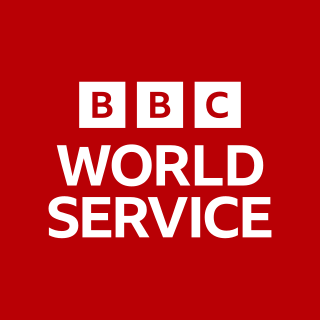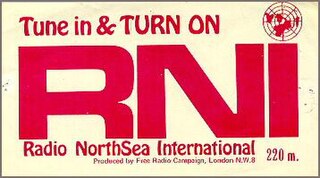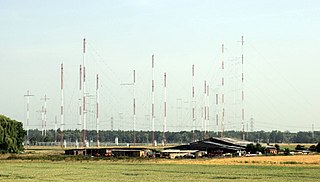
The BBC World Service is an international broadcaster owned and operated by the BBC. It is the world's largest external broadcaster in terms of reception area, language selection and audience reach. It broadcasts radio news, speech and discussions in more than 40 languages to many parts of the world on analogue and digital shortwave platforms, internet streaming, podcasting, satellite, DAB, FM and MW relays. In 2015, the World Service reached an average of 210 million people a week. In November 2016, the BBC announced that it would start broadcasting in additional languages including Amharic and Igbo, in its biggest expansion since the 1940s.

Shortwave radio is radio transmission using shortwave (SW) radio frequencies. There is no official definition of the band, but the range always includes all of the high frequency band (HF), which extends from 3 to 30 MHz ; above the medium frequency band (MF), to the bottom of the VHF band.
International broadcasting, in a limited extent, began during World War I, when German and British stations broadcast press communiqués using Morse code. With the severing of Germany's undersea cables, the wireless telegraph station in Nauen was the country's sole means of long-distance communication.

In radio communication, skywave or skip refers to the propagation of radio waves reflected or refracted back toward Earth from the ionosphere, an electrically charged layer of the upper atmosphere. Since it is not limited by the curvature of the Earth, skywave propagation can be used to communicate beyond the horizon, at intercontinental distances. It is mostly used in the shortwave frequency bands.
Radio Canada International (RCI) is the international broadcasting service of the Canadian Broadcasting Corporation (CBC). Prior to 1970, RCI was known as the CBC International Service. The broadcasting service was also previously referred to as the Voice of Canada, broadcasting on shortwave from powerful transmitters in Sackville, New Brunswick. "In its heyday", said Radio World magazine, "Radio Canada International was one of the world's most listened-to international shortwave broadcasters". However, as the result of an 80 percent budget cut, shortwave services were terminated in June 2012, and RCI became accessible exclusively via the Internet. It also reduced its services to five languages and ended production of its own news service.

Radio Netherlands was a public radio and television network based in Hilversum, producing and transmitting programmes for international audiences outside the Netherlands from 1947 to 2012.

Radio Moscow, also known as Radio Moscow World Service, was the official international broadcasting station of the Union of Soviet Socialist Republics until 1993. It was reorganized with a new name: Voice of Russia, which has also since been reorganized and renamed Radio Sputnik. At its peak, Radio Moscow broadcast in over 70 languages using transmitters in the Soviet Union, Eastern Europe, and Cuba.

Radio London, also known as Big L and Wonderful Radio London, was a top 40 offshore commercial station that operated from 23 December 1964 to 14 August 1967, from a ship anchored in the North Sea, three and a half miles (5.6 km) off Frinton-on-Sea, Essex, England.
The strict definition of a pirate radio station is a station that operates from sovereign territory without a broadcasting license, or just beyond the territorial waters of a sovereign nation from on board a ship or other marine structure with the intention of broadcasting to that nation without obtaining a broadcasting license from that nation.
Radio Newyork International was the name of a pirate radio station which broadcast from a ship anchored in international waters off Jones Beach, New York, United States in 1987 and 1988. The history of Radio Newyork International (RNI) is linked with the Falling Star Network and other New York City area pirate radio stations. The owner of RNI, Allan Weiner, is currently the licensee of WBCQ shortwave in Monticello, Maine.
Shortwave broadcasting in the United States allows private ownership of commercial and non-commercial shortwave stations that are not relays of existing AM/MW or FM radio stations, as are common in Africa, Europe, Asia, Oceania except Australia and Latin America. In addition to private broadcasters, the United States also has government broadcasters and relay stations for international public broadcasters. Most privately owned shortwave stations have been religious broadcasters, either wholly owned and programmed by Roman Catholic and evangelical Protestant charities or offering brokered programming consisting primarily of religious broadcasters. To better reach other continents of the world, several stations are located in far-flung US territories. Shortwave stations in the USA are not permitted to operate exclusively for a domestic audience; they are subject to antenna and power requirements to reach an international audience.

Radio Veronica was an offshore radio station that began broadcasting in 1960, and broadcast offshore for over fourteen years. It was set up by independent radio, TV and household electrical retailers in the Netherlands to stimulate the sales of radio receivers by providing an alternative to the Netherlands state-licensed stations in Hilversum.
Radio jamming is the deliberate jamming, blocking or interference with wireless communications. In some cases, jammers work by the transmission of radio signals that disrupt communications by decreasing the signal-to-noise ratio.
HCJB, "The Voice of the Andes", was the first radio station with daily programming in Ecuador and the first Christian missionary radio station in the world. The station was founded in 1931 by Clarence W. Jones, Reuben Larson, and D. Stuart Clark. HCJB now focuses on Ecuador with unified programming on FM at 89.3 MHz in Pichincha, at 92.5 MHz in Manabí, at 96.1 MHz in Tungurahua and Cotopaxi, at 98.3 MHz in Esmeraldas and with separate programming on AM at 690 kHz. Broadcasts in Spanish and indigenous languages on 6.05 MHz (1 kW), continue on an intermittent basis with a new solid state transmitter which in 2017 replaced an older (5 kW) transmitter. These broadcasts were not listed on the HCJB English website as of February 2016.

DZFE is a radio station owned and operated by Far East Broadcasting Company (Philippines). The station's studio and transmitter are located on the 46th floor of One Corporate Centre, Meralco Ave. cor. Doña Julia Vargas Ave., Ortigas Center, Pasig. This station operates daily from 6:00 AM to 3:00 AM.

Radio North Sea International was a European offshore radio station run by the Swiss firm Mebo Telecommunications, jointly owned by Swiss engineer Edwin Bollier and his business partner, Erwin Meister. RNI broadcast for less than five years in the early 1970s and, courting both disaster and success, made a modest financial profit.
RDP Internacional - Rádio Portugal, is an international radio broadcasting station of Rádio e Televisão de Portugal. It aims at overseas Portuguese communities in Europe, Africa, South America, North America, India/Middle East as well as East Timor.

Curtain arrays are a class of large multielement directional radio transmitting wire antennas, used in the shortwave radio bands. They are a type of reflective array antenna, consisting of multiple wire dipole antennas, suspended in a vertical plane, often in front of a "curtain" reflector made of a flat vertical screen of many long parallel wires. These are suspended by support wires strung between pairs of tall steel towers, up to 90 m high. They are used for long-distance skywave transmission; they transmit a beam of radio waves at a shallow angle into the sky just above the horizon, which is reflected by the ionosphere back to Earth beyond the horizon. Curtain antennas are mostly used by international short wave radio stations to broadcast to large areas at transcontinental distances.
PCJJ was a pioneering shortwave radio station in the Netherlands operated by Philips Radio on behalf of Philips Laboratories, a division of Philips Electronics. It was the first shortwave radio station in Europe, and the first dedicated shortwave radio station in the world - previous stations had simulcast AM/medium wave broadcasts.

Far East Broadcasting Company (FEBC) is an international Christian radio network. From 1960 to 1994, FEBC owned and operated shortwave radio station KGEI in San Francisco, California.










